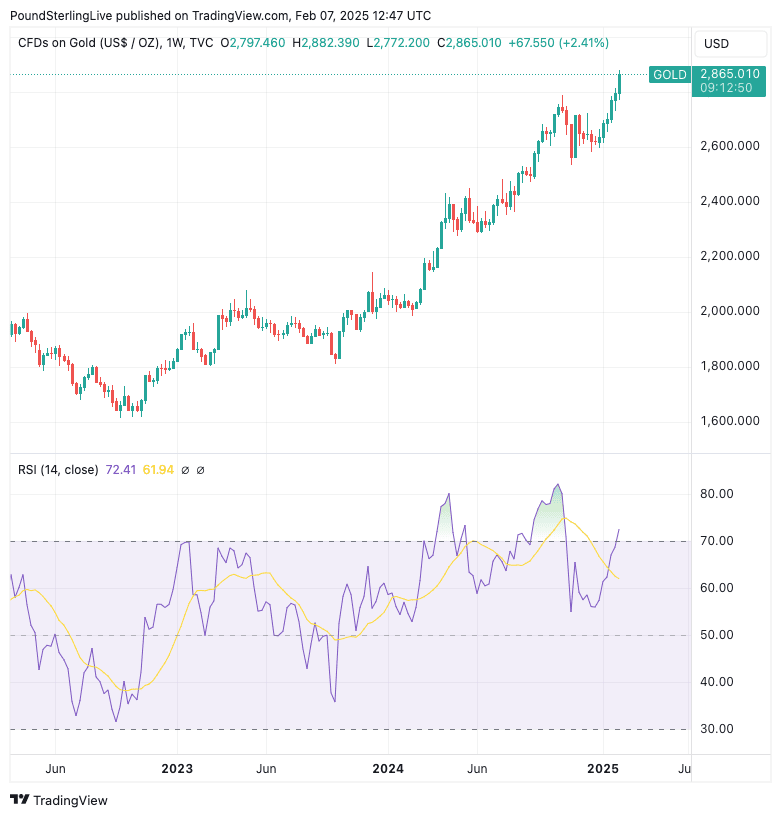Gold's 'Real' All-time Highs Still Beckon
- Written by: Gary Howes

Image © Adobe Stock
Gold prices haven't yet reached all-time highs; at least when we adjust for inflation, they haven't.
Anita Wright, Chartered Financial Planner at Bolton James, points out that despite gold’s recent surge in price, it remains lower in real terms than it was in the early 1980s.
"In today's money, that $850 peak in 1980 is equivalent to roughly $3,000–$3,500 per ounce, meaning gold has not yet surpassed its inflation-adjusted all-time high," she says.
The spot price of gold trades at $2865 at the time of writing as the precious metal looks to notch a sixth consecutive weekly gain.
Wright says the advance comes despite some of the economic factors that traditionally support gold not currently in play, such as a weak dollar, low interest rates, and negative real yields.
However, demand is being largely driven by geopolitical factors and central bank reserve portfolio diversification.
"Given that these factors seem likely to persist — and with the potential for Trump to weaken the dollar —gold could see further upward momentum," says Wright.
The next big target is the £3K level in gold; however, "the weekly chart RSI indicator is screaming overbought so we should be prepared for short-term setbacks in the journey higher," says Dennis Falt, a metal pricing analyst for Earth Rarest Metals Company.
Above: Gold prices are overbought according to the weekly chart's RSI (lower panel). The RSI also tells us that overbought conditions can persist for long periods.
"Despite the enduring bullish outlook, the rapid climb in gold prices could lead to significant volatility. With a series of unprecedented highs, the gold market risks overheating and may face bouts of profit-taking, so investors should brace for short-term fluctuations as gold reaches new heights," says Gabriel McKeown, Head of Macroeconomics at Sad Rabbit Investments.
"We maintain our bullish stance on gold, with prices expected to reach a record high of USD2900/oz in 2025," says a note from Daniel Hynes, Senior Commodity Specialist at ANZ.
"Strong investment inflows, resilient physical demand, and elevated central bank purchases will keep gold on a strong footing," he adds.
Gold reached a new all-time high in nominal terms this week as investors sought safety amid market uncertainty relating to Donald Trump's tariff threats on Canada and Mexico, which were ultimately delayed.
However, the U.S. placed tariffs on China, which retaliated in kind with its own set of tariffs and sanctions.
Also driving demand for safe-haven assets is the stalled disinflation process across the world; the UK's Bank of England on Thursday said it had hiked its inflation forecasts for 2025 to above 3.0%.
Despite the upgrade, the Bank cut rates and committed to further cuts.
"An upcoming spree of central bank monetary easing is propelling gold on a relentless upward trajectory with seemingly ample room for further gains. This, combined with a world rife with international turmoil and trade war escalations, could be the spark that pushes gold prices to the $3,000 threshold," says McKeown.
Wes Wilkes, CEO at Net-Worth NTWRK, says the fundamental driver for gold's continuous trend upwards right now is an insatiable appetite for gold from global, and in particular emerging market, central banks.
"Many are preferring gold to US Treasuries or any other asset. This insatiable appetite means that we are unlikely to have seen the last all-time high for gold in 2025 or even quarter one," he explains.
